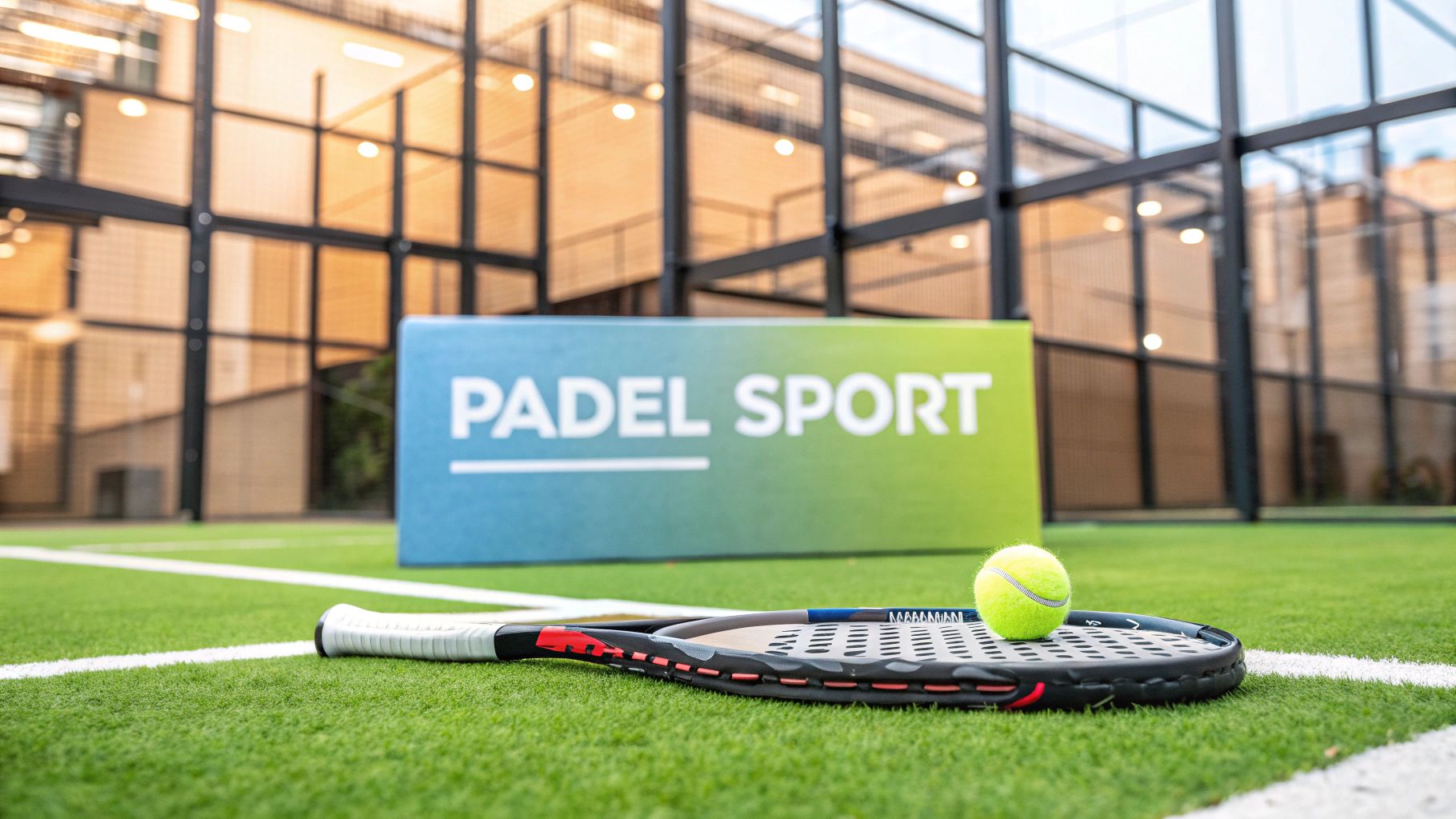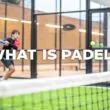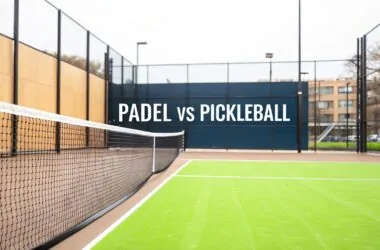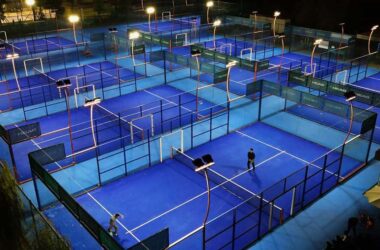So, what is this sport called padel that everyone seems to be talking about? In a nutshell, padel is an electrifying racket sport that feels like a perfect mashup of tennis and squash. It's played in doubles on a court enclosed by glass walls, and here's the kicker—those walls are part of the game. This simple twist makes it incredibly social and an absolute blast to play.
Understanding Padel: The Basics Explained
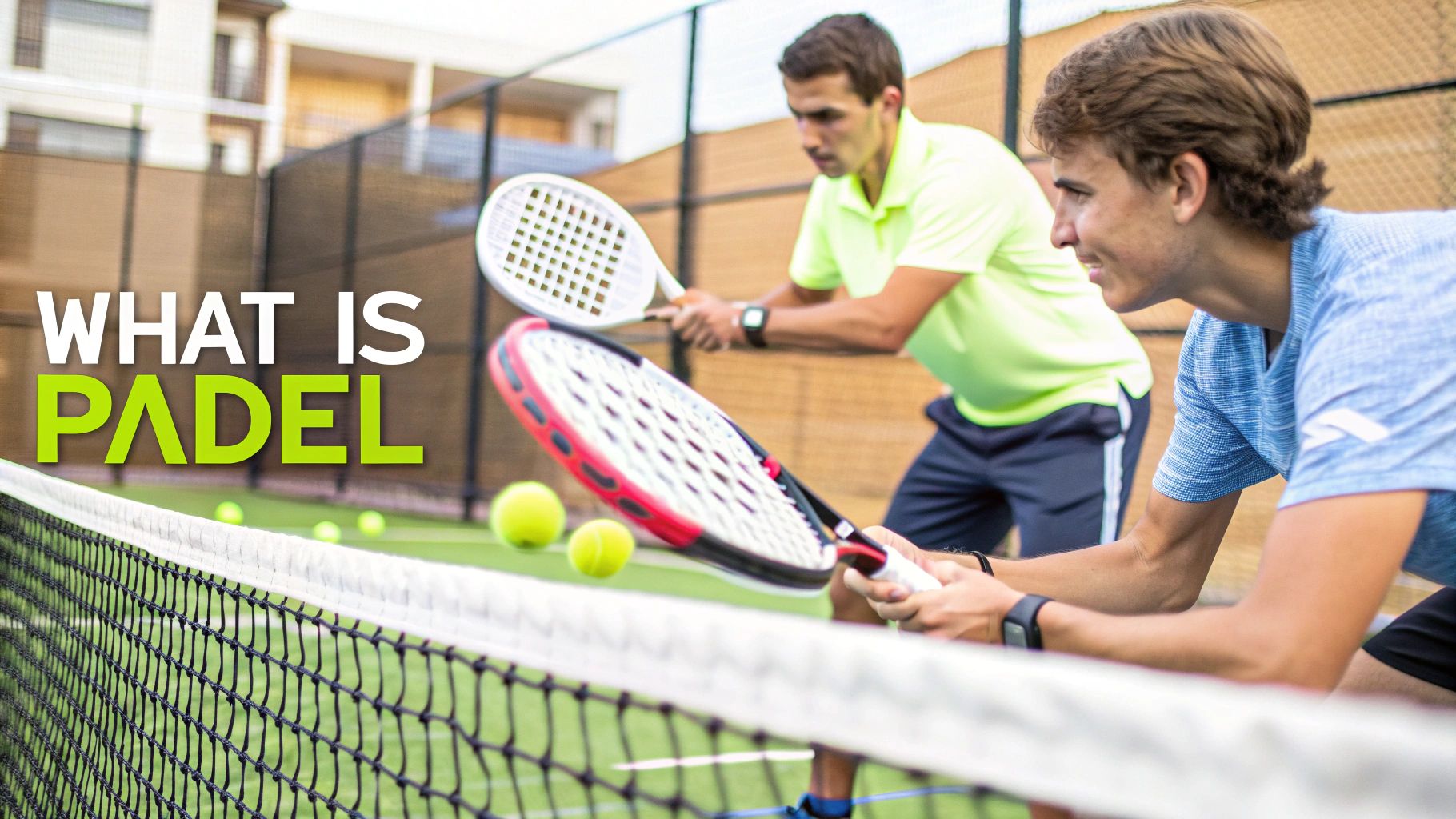
The easiest way to picture padel is to think of it as tennis inside a glass box. The court is noticeably smaller than a tennis court, which naturally brings the players closer together. This proximity encourages quick, strategic rallies over sheer, overpowering serves. It’s this unique setup that creates a game where clever positioning and teamwork often trump raw power.
One of the biggest reasons for its exploding popularity is just how easy it is to get started. Tennis can have a pretty steep learning curve, but most beginners can pick up padel in minutes. The serve is a simple underhand motion, and the racket—or 'pala'—is solid and stringless, making it much easier to control the ball. This means new players can get into fun, extended rallies almost right away.

Buy the best padel gear to level up your next game!
CHECK OUT this deal from Padel Market!Get ready to take your game to the next level with the latest padel gear from Padel Market! Fast EU and Worldwide Shipping
To give you a quick overview, here's a simple breakdown of the sport's key features.
Padel at a Glance
| Feature | Description |
|---|---|
| Players | Played in doubles (two players per team). |
| Court | 20m x 10m, enclosed by glass and mesh walls. |
| Scoring | Same as tennis: 15, 30, 40, deuce, ad, game. |
| Racket | A solid, perforated "pala" with no strings. |
| Serve | Must be underhand, bouncing the ball once first. |
| Ball | Similar to a tennis ball but with slightly less pressure. |
| Gameplay | The ball can be played off the glass walls after bouncing once on the court. |
As you can see, the game's design is brilliantly simple, yet it allows for a surprising amount of depth and strategy as you improve.
Why Is Padel So Popular?
The game is fundamentally built for community and teamwork. Since it's almost exclusively played in doubles, you're constantly communicating with your partner. The enclosed court keeps the ball in play longer and creates a lively, contained atmosphere where camaraderie just naturally blossoms. It's this perfect storm of being easy to learn yet challenging to master that has captivated millions of people.
Padel is a perfect mix of physical activity and social fun. Its format encourages longer rallies and strategic plays, making every game an engaging experience for players of all skill levels.
And this isn't just a feeling; the numbers back it up. Padel is widely recognized as the world's fastest-growing sport. In a single recent year, over 3,282 new clubs opened their doors worldwide—that’s an average of one new club opening every 2.5 hours!
If you'd like to dive deeper, you can learn more about the unique characteristics of what makes padel sport so special in our complete guide. This incredible expansion has pushed the global court count past 50,000, a clear sign of its massive and still-growing popularity.
The Surprising Story Behind Padel's Global Rise
Every great sport has an origin story, but padel's tale is one of happy accidents and high-society flair. This isn't a sport cooked up by a committee or in a corporate lab. It was born in 1969 from a very practical problem at a private home in Acapulco, Mexico.
A wealthy businessman named Enrique Corcuera wanted to play tennis on his property, but he just didn't have enough space for a full-sized court. His solution? Pure genius. He built a smaller court and, to keep the ball from flying into his neighbor's garden, he enclosed it with high walls. What he and his guests quickly realized was that playing off these walls made for a completely new, incredibly addictive game. The ball stayed in play longer, rallies were suddenly more strategic, and the whole thing was just more social and fun.
From Acapulco to the World
One of Corcuera's regular guests was his friend from Spain, Prince Alfonso de Hohenlohe. He was absolutely captivated by this new game. In 1974, he took the idea back with him and built the first two courts in Spain at the exclusive Marbella Club.
Surrounded by European jet-setters and affluent holidaymakers, padel found its first home outside of Mexico. It quickly became a status symbol, the go-to pastime for the elite in Spain and Argentina. But while it started with an air of sophistication, its real magic was how easy and fun it was for anyone to play. It didn't take long for the sport to break out of the private clubs and spill into the public domain, sparking a grassroots movement that's still exploding today.
Padel's journey from a backyard fix to a worldwide sensation says everything about its universal appeal. It started as a clever solution for a small space but became a sport that connects people everywhere.
The Modern Padel Boom
That journey from a niche hobby to a mainstream obsession has hit lightspeed in recent years. For a long time, the padel universe revolved almost entirely around Spain and Argentina, which together had about 85% of all the courts in the world.
Today, that number has dropped to just 35%. It's not because they're playing less—far from it. It’s because the rest of the world is finally catching on, and fast. You can dive into more stats about padel's incredible growth across more than 150 countries on miamipremierpadel.com. This isn't just a history lesson; it's the backstory for why this sport keeps winning over hearts and minds all over the globe.
Your Guide to the Padel Court and Equipment
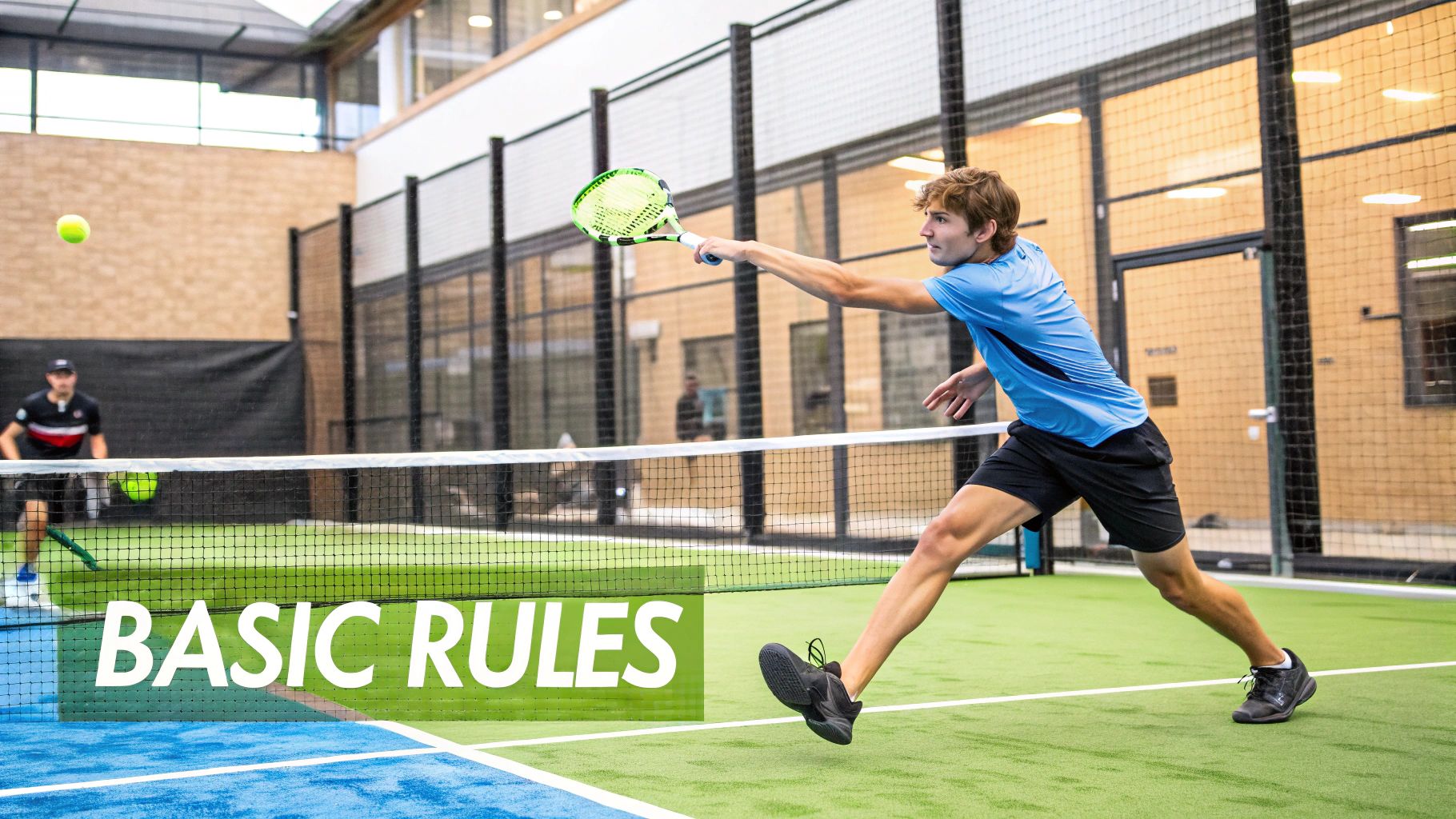
To really get what padel is all about, you need to understand its unique playground and the gear that goes with it. This isn't like other racquet sports where the court is just a boundary. In padel, the court is practically your fourth teammate, an active part of every single rally.
Let's break down the court first, then we'll get into the tools of the trade.

Buy the best padel gear to level up your next game!
CHECK OUT this deal from Padel Market!Get ready to take your game to the next level with the latest padel gear from Padel Market! Fast EU and Worldwide Shipping
A padel court is a compact rectangle, 10 meters wide by 20 meters long, which feels much cozier than a sprawling tennis court. This entire area is boxed in by walls—usually tough, reinforced glass at the back and sides, with wire mesh finishing the job. But these walls aren't just there to keep the ball in play. They are in play.
Imagine the court as a strategic arena. Once the ball bounces, you can play it off most of the glass walls. This completely changes the game. A shot that looks like a clean winner sailing past you can suddenly be returned with a clever bank shot off the back wall, leading to some incredibly long and mind-bending rallies.
The Tools for Padel Success
Just like the court, the equipment is totally unique to the sport. It’s all specifically designed for padel's fast, strategic gameplay. So, if you're thinking of a traditional stringed racquet, think again. The padel racquet, or “pala” as it’s known, is a different beast entirely.
The pala is a solid, stringless racquet. It has a foam core wrapped in materials like carbon fiber or fiberglass, and it’s peppered with holes to cut down on air resistance and make it lighter. This solid design is a game-changer for control, making it much easier to place the ball exactly where you want it.
Padel racquets come in three main shapes, each with its own feel:
- Round: These have the biggest sweet spot right in the middle, giving you maximum control. They're perfect for beginners just getting a feel for the game.
- Teardrop: A great middle-ground, balancing power and control. This is the go-to for most intermediate players.
- Diamond: The sweet spot is higher up on the head, which generates a ton of power. This shape is usually favored by advanced players looking to hit aggressive, attacking shots.
Understanding the Padel Ball and Footwear
The padel ball might look like a regular tennis ball, but there's a subtle difference: it has slightly less internal pressure. This means it bounces a bit slower and lower, giving you that extra split second to prepare your shot. It’s a small change, but it’s crucial for encouraging those long, strategic rallies over just raw power.
The combination of a solid pala and a low-pressure ball is the secret to padel's accessibility. It makes controlling the ball much simpler, allowing new players to enjoy full rallies from their very first game.
Finally, don't overlook your shoes. You might be tempted to grab your running shoes, but you'll be slipping all over the place. Padel shoes are built with special herringbone or omni-patterned soles designed for the perfect amount of grip on the artificial turf. They allow you to make the quick pivots, sharp lateral moves, and sudden stops that are essential to playing well.
For a deeper dive into the nitty-gritty, check out this comprehensive overview of the padel court and its unique features for more details.
How to Play Padel: The Essential Rules
Okay, you've got the court and the gear sorted. Now for the fun part: actually playing the game. The great thing about padel is that its rules are pretty straightforward, borrowing a lot from tennis but with a few game-changing twists that give it a unique flavor. Getting a grip on these fundamentals is your first real step into this addictive sport.
The game kicks off with an underhand serve. Forget the aggressive, over-the-top serves you see in tennis; that's not how we do it here. You have to drop the ball, let it bounce once, and then hit it at or below your waist level. The serve needs to go diagonally across the net and land in your opponent's service box. This much simpler serving motion is a huge reason why even total beginners can get a rally going almost immediately.
Scoring and Winning a Point
If you've ever kept score in a tennis match, you're already ahead of the game. Padel uses the exact same scoring system: 15, 30, 40, and game. When the score hits 40-40, we call it "deuce," and a team has to win two points in a row to take the game. A set is won by the first team to win six games, as long as they have a two-game lead.
So, how do you win a point? It's simple:
- The ball bounces twice on your opponent's side of the court.
- Your opponent smacks the ball into the net.
- Your opponent hits the ball out of the playing area (either straight out or after hitting a wall).
- The ball hits an opponent directly before it bounces on their side.
For a deeper dive into the nitty-gritty, you can get more details on the official rules of padel and common scenarios. Knowing the finer points can really give you a strategic leg up.
The Most Exciting Rule: Using the Walls
This is where padel really comes to life and shows its true colors. Those glass walls aren't just there to keep the ball in; they're an active part of the game. After the ball has bounced once on your side, you can let it rebound off one or more walls before you hit it back over to your opponent.
Using the walls is the secret to turning defense into offense. A shot that looks totally out of reach can be played easily off the back glass, buying you precious time to reset and hit a quality return. It feels a bit strange at first, but mastering wall play is what separates good players from great ones.
Picture this: your opponents hit a blistering shot deep into your back corner. Instead of a desperate lunge, you can just step aside, let the ball ricochet off the back wall, and play it as it calmly comes back towards you. This adds a fantastic layer of what I like to call "physical chess" to every single rally.
For those coming from a tennis background, it can be tricky to visualize just how different the gameplay feels. This quick table breaks down the main distinctions.
Padel vs Tennis Key Differences
| Aspect | Padel | Tennis |
|---|---|---|
| Court Size | Smaller (20m x 10m), enclosed by walls | Larger (23.77m x 10.97m), open court |
| Serve | Underhand, must bounce before contact | Overhand or underhand, direct hit |
| Walls | In play, can be used for rebounds | Not applicable, ball is out if it hits surroundings |
| Racket | Solid, stringless "pala" with perforations | Strung racket, larger head size |
| Net Height | 88 cm at the center | 91.4 cm at the center |
| Players | Almost always played in doubles | Played in singles or doubles |
As you can see, these differences completely change the dynamic of the game. Padel’s smaller, enclosed court naturally leads to longer, more strategic rallies where placement and wall-play trump raw power.
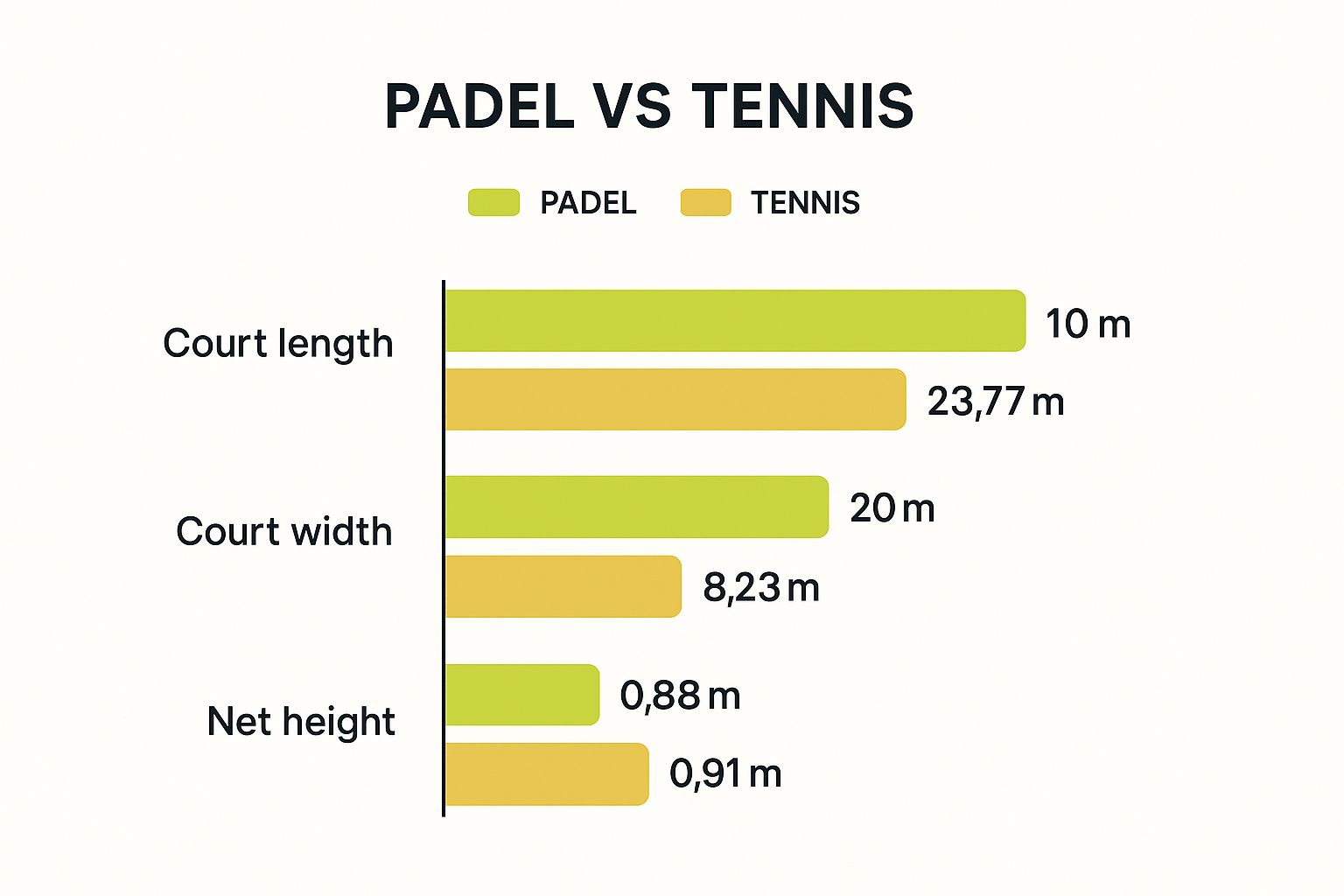
This image really drives home how the compact nature of the padel court encourages tactical play and constant use of the walls, a world away from the power baseline game often seen in tennis.
Why People Love Padel Beyond the Court
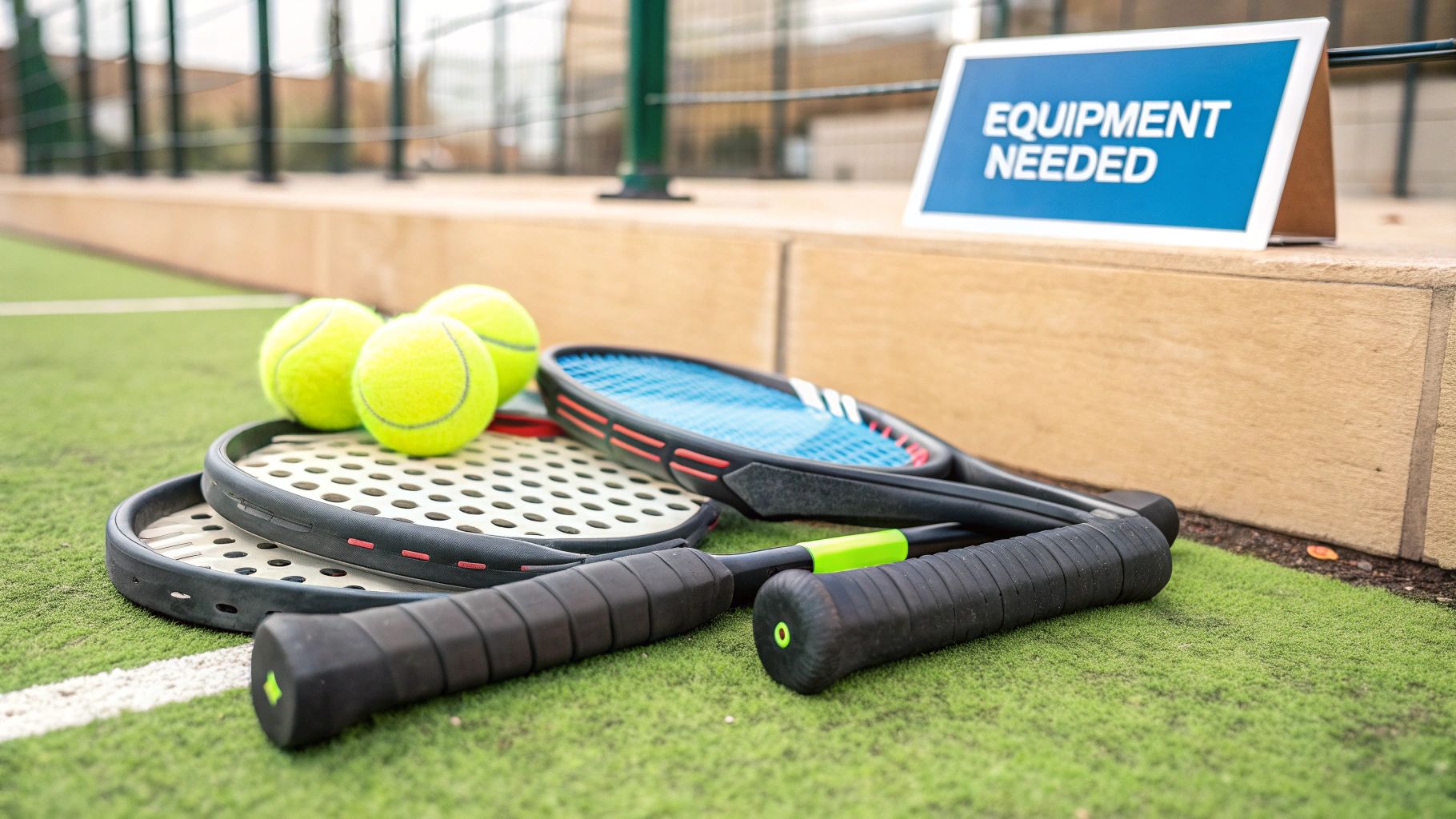
The explosion of padel's popularity isn't just about the on-court action. Sure, it's a blast to play, but the real reason people get hooked is the whole package. It’s that rare sport that perfectly blends a great workout, genuine social connection, and a surprising mental challenge.
From a physical standpoint, padel is a brilliant way to fire up your cardio, sharpen your reflexes, and improve agility. The constant motion, quick pivots, and snappy rallies get your heart rate up in no time. But here's the kicker: it's a lower-impact sport than its cousins, tennis and squash. The smaller court and artificial turf are much kinder to your knees and joints, making it a game you can play for years to come, no matter your age.
The Social Heartbeat of Padel
Honestly, the real magic of padel often happens between points. It’s almost always played in doubles on a cozy, enclosed court, which means players are never far apart. This setup naturally sparks communication, teamwork, and a real sense of camaraderie. You aren't just hitting a ball; you're strategizing and celebrating with your partner, right by your side.
This social dynamic is baked into the sport's DNA, creating a friendly and supportive vibe. The enclosed court keeps the banter and laughter contained, making every match feel less like a competition and more like a get-together.
Padel is more than just a sport; it’s a community builder. Its design fosters interaction and teamwork, transforming a simple game into a powerful social activity where friendships are forged.
Padel as a Mental Workout
Beyond the physical fun and social buzz, padel is a seriously strategic game. So much so that people often call it “physical chess.” This isn't a game you can win with brute force alone. Victory comes from outthinking your opponents with smart positioning, a variety of shots, and—most importantly—using the walls to your advantage.
Learning to read how the ball will ricochet off the back and side glass adds an incredible tactical layer to the game. You have to think one or two shots ahead, constantly looking for ways to turn a defensive scramble into an offensive attack with a perfectly placed wall shot. It makes every rally a dynamic puzzle that works out your brain as much as your body.
This unique combination of benefits has created a fiercely passionate global community. The proof is in the numbers. The international pro circuit has expanded at a dizzying pace, with the number of tournaments nearly doubling from 71 to 132 in just the first half of a recent year, drawing in athletes from over 90 countries. You can learn more about padel's phenomenal global expansion and community growth on tennistonic.com. This surge is a testament to the sport's incredible power to bring people together.
Your Padel Questions Answered
Alright, so you’re ready to jump onto the court for the first time. It's totally normal to have a few last-minute questions floating around. The leap from knowing what padel is to actually playing can feel like a big one, but trust me, it’s much simpler than it looks. Let's tackle some of the most common queries to make sure you walk on that court with complete confidence.
One of the first things people wonder is if they need to rally a friend before they can even book a court.
Do I Need a Partner to Start Playing Padel?
Even though padel is a doubles game, the brilliant news is that you absolutely do not need to show up with a partner. The whole social side of the sport is built to connect people. Most padel clubs and community apps, like Playtomic, are designed specifically to help you find games and link up with other players at your exact skill level.
Clubs often run "mix-in" sessions, round robins, or ladder leagues where you can just turn up on your own. You'll get paired with different partners and play against various opponents all in one session. This is a huge reason the sport has exploded in popularity—it gets rid of the headache of finding a foursome, making it incredibly easy for anyone to get involved and meet new people.
This accessibility naturally brings up the next question: what's this going to cost?
Is Padel an Expensive Sport to Play?
Padel is widely seen as a very affordable sport, and a game often works out to be cheaper per person than tennis. The main cost is renting the court, but that fee is always split between four players, which immediately slashes the individual price.
As for gear, you don’t need to break the bank to get started. A solid beginner's padel racket (called a "pala") usually costs less than a mid-range tennis racket. Even better, almost every single padel club offers rental equipment, including rackets and balls, for a tiny fee. This low barrier to entry means you can give the sport a proper try without having to commit any serious cash upfront.
So, you know it's easy to find a game and it won't drain your wallet. What should you watch out for on the court?
The biggest mistake beginners make is trying to play padel like it's tennis. Resisting the urge to hit every ball with maximum power and instead focusing on control and strategy is the fastest way to improve.
What Is the Biggest Mistake Beginners Make?
By a country mile, the most common mistake new players make—especially those coming from tennis—is hitting the ball way too hard. Padel is a game of patience, placement, and smarts, not brute force. Real success comes from controlling the ball, talking to your partner, and using the walls to outsmart your opponents. Trying to blast winners past everyone will just lead to frustration and a lot of balls hitting the back glass on the full.
Another classic rookie error is forgetting to use the back wall. It feels completely unnatural at first, but letting the ball go past you to play it off the back glass is a fundamental shot. Learning to master this defensive move and turn it into an attack is a major milestone for any developing player.
How Are Skill Levels Measured in Padel?
To make sure games are competitive and fun for everyone, padel uses a simple numerical scale to measure skill levels. The rating system generally runs from 1.0 (a total newcomer) all the way up to 7.0 (a touring professional).
This system is built right into most club booking platforms and player apps. It’s a fantastic tool for matching you with three other people of a similar ability, so you're always in for a good, balanced game.
Here’s a quick guide to what the levels generally mean:
- 1.0 – 2.5: Beginners who are just getting the hang of the rules, basic shots, and where to stand on the court.
- 3.0 – 4.5: Intermediate players who can hold a rally, are comfortable using the walls, and understand basic tactics.
- 5.0 and above: Advanced and competitive players who have consistent shots and a deep strategic grasp of the game.
At Padel Rumors, we're here to guide you through every step of your journey, from your first hit to your first tournament. Explore our guides, gear reviews, and pro insights to take your game to the next level. Find everything you need at https://www.padelrumors.com.





